Without a doubt, Juventus are among the very best teams in Europe. They are the most successful team in Italy also, winning the Serie A a record 35 times. This is especially true within the last decade, where they have been extremely dominant domestically, winning the Scudetto in every single campaign of the last eight seasons.
Aside from the fact that they are the best team in Italy and every season a serious contender to win the UEFA Champions League, they are also well known for their clever transfers. In this recruitment analysis, we will use statistics and data from Transfermarkt to dig deeper into their actions on the transfer market within the last couple of seasons. The goal is to get a better understanding of their recruitment and transfer strategy respectively to evaluate if they live up to their reputation.
A first overview of the arrivals
In the first part of this analysis, we will talk about their signings and arrivals respectively, in the second one we take a closer look at their current squad and, at the end, we discuss their departures. Before we go into more detail and look into the different statistics and numbers of the recruitment process of Juventus, we will try to get a basic overview. Also, I need to clarify that in this article players who return from a loan aren’t counted as new arrivals. Furthermore, we will be combining the summer and winter signings per season to have a better overview.
In the first graph, which can be seen below, I visualised the basic numbers of their signings within the last five seasons.
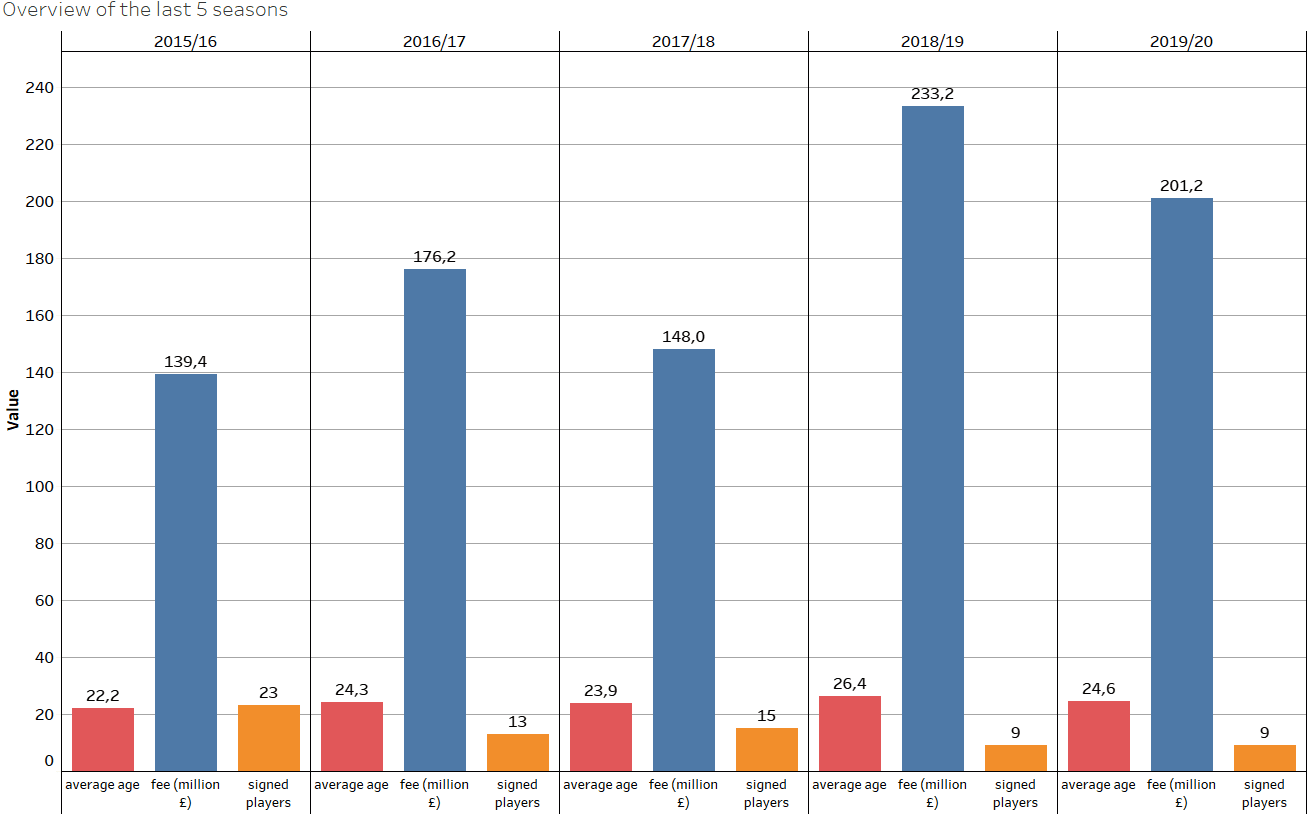
First of all, we can clearly see that the amount of money that they spend grows from season to season. At this point it is important to note that this is a trend that reflects the overall market, and not something that is a unique characteristic of Juventus. However, we will come back to this topic once more at another point in this recruitment analysis.
Overall, they signed 69 players during these five seasons, averaging an age of 23.84 years. Six of these signings were players who joined them on loan while the remaining 63 men signed a permanent deal with Juve. At this point, I must note that, for example, Juan Cuadrado who joined them twice on loan from Chelsea and just then signed a permanent deal is logically counted as three signings and not just as one. Therefore, in truth, they brought in 64 players, however, some of them spent a few years at the club before signing permanently.
All in all, they spent £897,974 million on new players over the last five seasons and 20 of these signings are currently part of the first team. Next, we want to know from where they mainly bring in their players and if there is a certain trend.
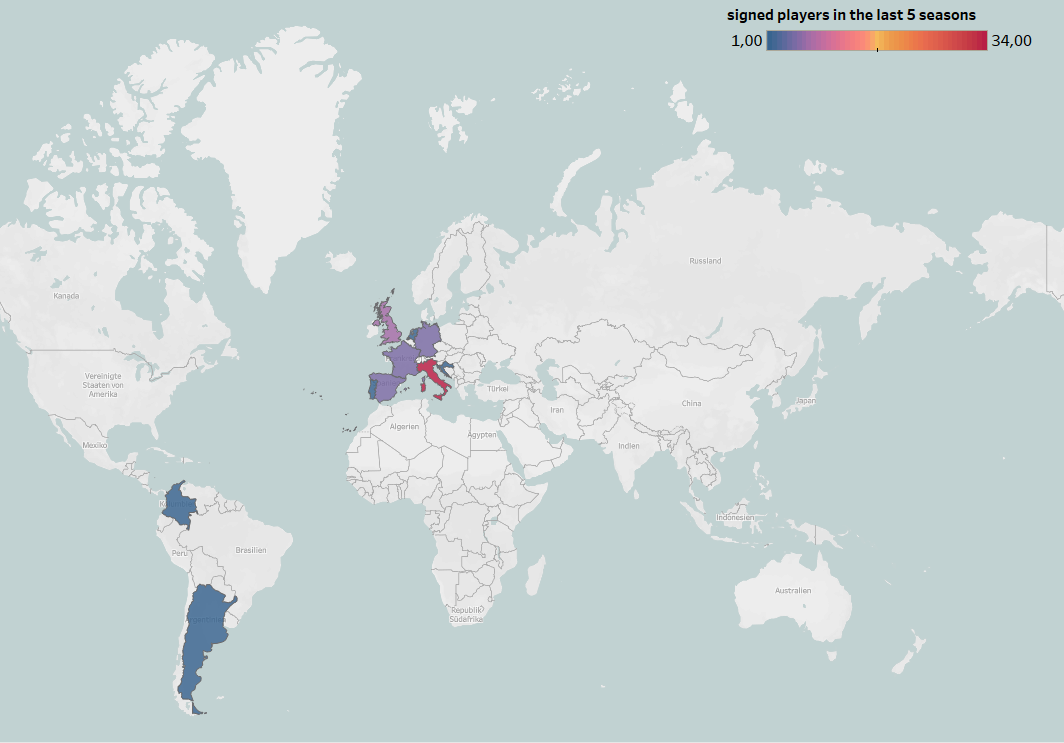
For this graph I excluded the eight players who were promoted from their own under 19 side. Therefore, we have 61 transfers left and we can clearly see that the majority of these were when Juventus signed a player from another Italian side from the first four tiers (34). The Old Lady additionally signed players from the other big leagues in Europe. Seven times they brought in a man from the EPL, five times from the Bundesliga, five times from the Ligue 1 and also five times from La Liga. That is understandable as they know that these players are used to the level of play when they move to the Serie A.
They also brought in a few players from outside of Europe’s top league, many with high success. Examples are Alex Sandro who they signed from Porto, Matthijs de Ligt from Ajax and Rodrigo Bentancur from Boca Juniors.
As the last point for this section, we look at the types of deals and how much money they spent in the past five seasons. Therefore, I separated the deals into six groups as we can see below. The players from the own under 19 side are logically part of the free transfer group.
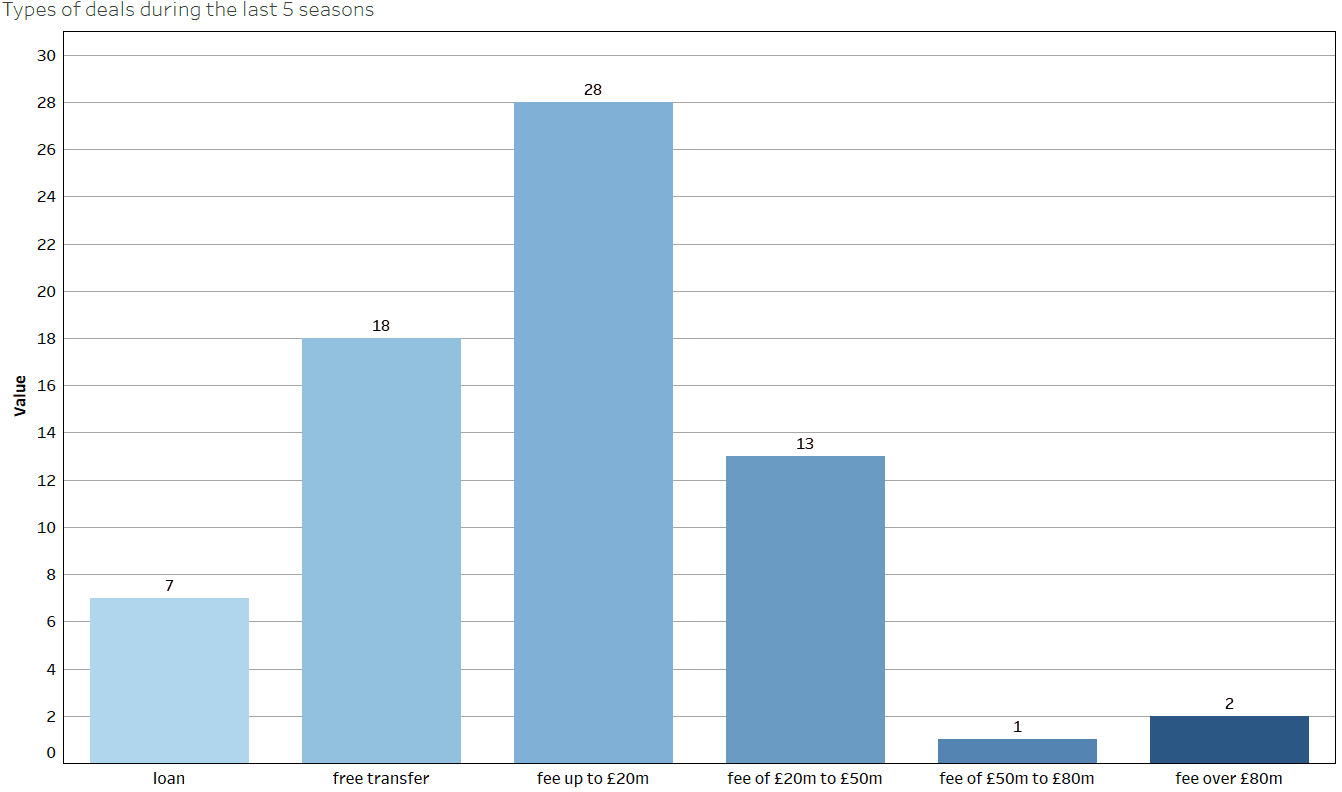
Basically, we can see that they mainly sign players for up to £20 million. We will see at the last stage of this recruitment analysis what happens with those players. The three most expensive players in the last five seasons are De Ligt (£76.95m), Gonzalo Higuaín (£81m) and Cristiano Ronaldo (£105.3m).
Current squad
In the second part of the recruitment analysis, we will look at the interesting statistics and data of the current senior team of the Old Lady. The main reason we look at the data of Maurizio Sarri’s squad is that the transfer strategy over the last five seasons should ideally reflect the team’s style or play, or tell us more about what we can expect from the side in the future.
In the first graph, the market values and fees will be again the central topics. This time, the three metrics that are interesting to us are the current market values of the players, the market values when they arrived at the club and how much Juventus paid for them. Also, for all players who at first joined Juve on loan and then signed a permanent deal, I calculated the paid fee by adding the loan fee to the transfer fee and, as the market value, I took the one when the player came to Juve on a permanent deal.
So, for example, Costa was a loanee at Juventus in the season 2017/18 and had a market value of £27 million at this time. Juventus had to pay Bayern Munich a loan fee of £5.4 million for this one season. After this one campaign, his market value raised to £49.5 million and the Old Lady brought him in on a permanent deal for £36 million. Because of this, in the graph it will show us the market value when he arrived as £49.5 million, but the paid fee as £41.4 million.
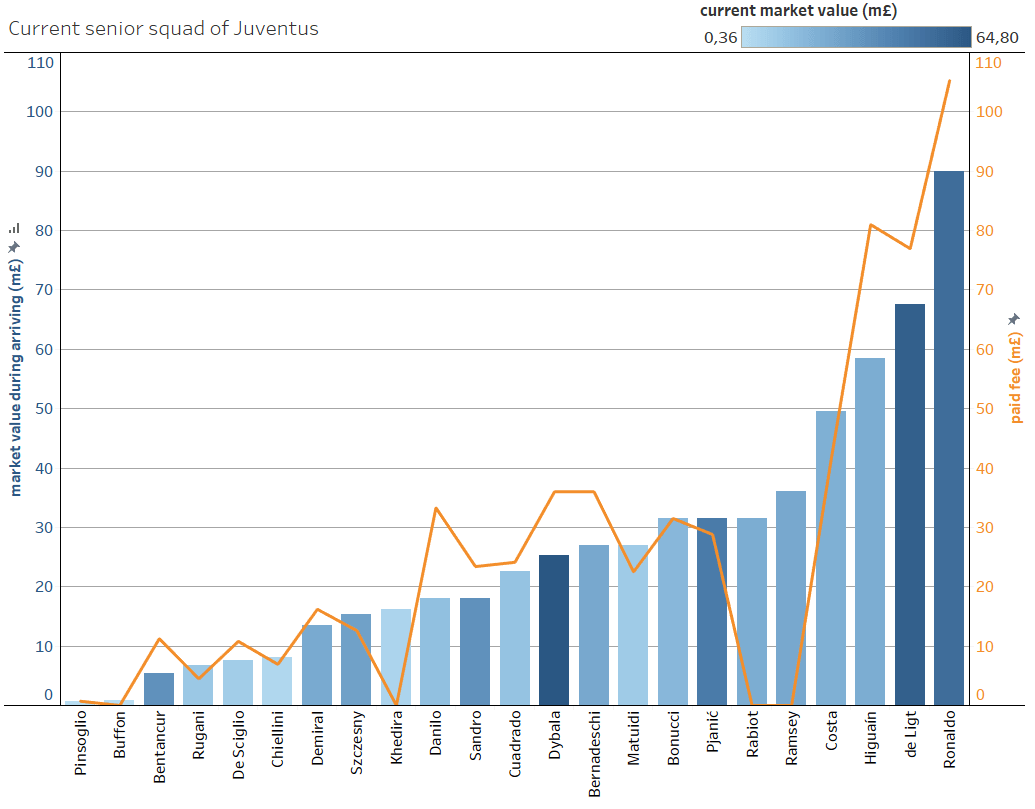
The first thing that immediately stands out here are the two free transfers of Aaron Ramsey and Adrien Rabiot. Additionally, they signed Khedira on a free transfer back in 2015 from Real Madrid. Also, Bentancur and Paulo Dybala are two examples for their intelligent recruitment as they signed these two men when they were 20 years old and 21 years old respectively for a cheap price compared to their current market value.
At this point, we must note something else as it seems a bit weird that Juve would pay £33 million for Danilo who is definitely not on the level of the best right-backs in the world. This transfer was a swap deal with Manchester City as they paid Juventus £58.5 million for João Cancelo while the Citizens received £33 million from Juve for Danilo. In other words, they exchanged these two right-backs and the Old Lady additionally received £25.5 million.
Frederico Bernadeschi and Higuaín are the only two men who weren’t able to show their full potential and qualities. Especially when you compare their performances with the fees which Juve paid for. They brought in Bernardeschi in 2017 for £36 million, but until now it seems like he couldn’t reach his full potential. He probably would need more time on the pitch to gain more confidence and it seems as though they haven’t found the right role and position for him yet.
On the other side, they signed Higuaín in 2016 for £81 million which makes him the second most expensive signing in the history of Juve right behind Ronaldo. Back then he was one of the absolute best strikers in the world and scored 36 goals in the Serie A for Napoli during the 2015/16 season. He also performed well for Juve, but for the money that they spent on him, they probably expected him to play for a longer time at a high level. He is currently an important player for Sarri, but not as amazing anymore as he was back then. This is understandable since the player is already 32-years-old.
Next, we will look at the age of the several players and how many minutes they played in this Serie A season (2340 available minutes). The players with a square instead of a dot have missed at least five games due to injuries.
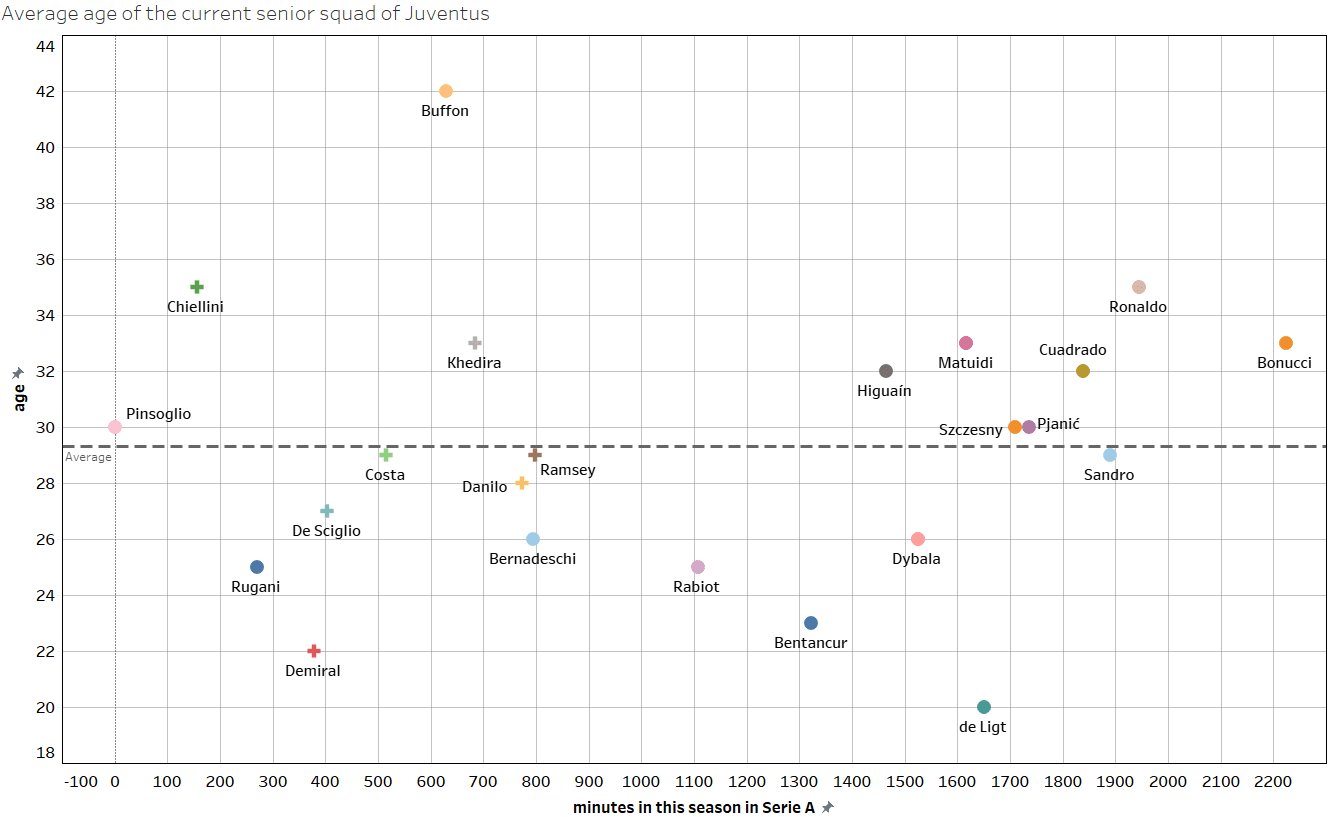
It becomes instantly visible that almost all important players in the team are around 30 years old or even older. De Ligt, Bentancur, Dybala and Rabiot are the only players who have played in this season at least 1000 minutes and aren’t 29-years-old or older.
Also, Demiral, De Ligt and Bentancur are the only under 24 players in the squad. In other words, you could say that they don’t have many young players in the senior squad, but, those they do have are big talents. Also, as previously mentioned, Bernadeschi doesn’t get much time on the pitch.
Furthermore, De Sciglio and Danilo are the only two right-backs in the team, but neither one of them has played more than 800 minutes this season. Of course, one reason for this is their injuries, but even when they were fit Sarri used Cuadrado as right-back who is usually a winger.
In the final graph of this section, we will look at the contracts of the current players. Please note that the end of each player’s line is not when the contract expires, but how old they are today when this magazine is published (25 June). The colours tell us when their contracts with Juventus expire.
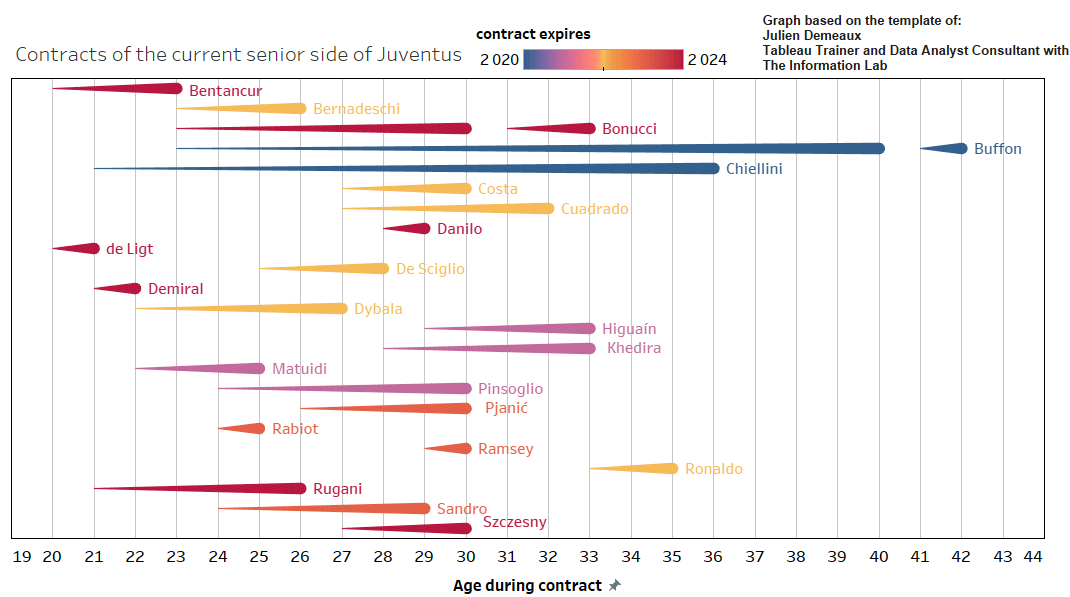
While the contracts of Buffon and Chiellini will run out at the end of this season, the contracts of the young and promising men all expire in 2024. Also, with Wojciech Szczęsny and Leonardo Bonucci, these two important and experienced players have a long-term contract with the club. It will be interesting to see what will happen with Blaise Matuidi, Miralem Pjanić and Higuaín as they are important players, but their contract will expire in 2021.
Selling and loaning system
In the final part of the analysis, we will talk about the players who left the club and before providing a final financial overview. Firstly, we will look at all the departures that brought in at least £10 million within the last five seasons. In the graph below we can see these men, how much Juve paid for them, for which figures they sold them and how many seasons the players were at the club.
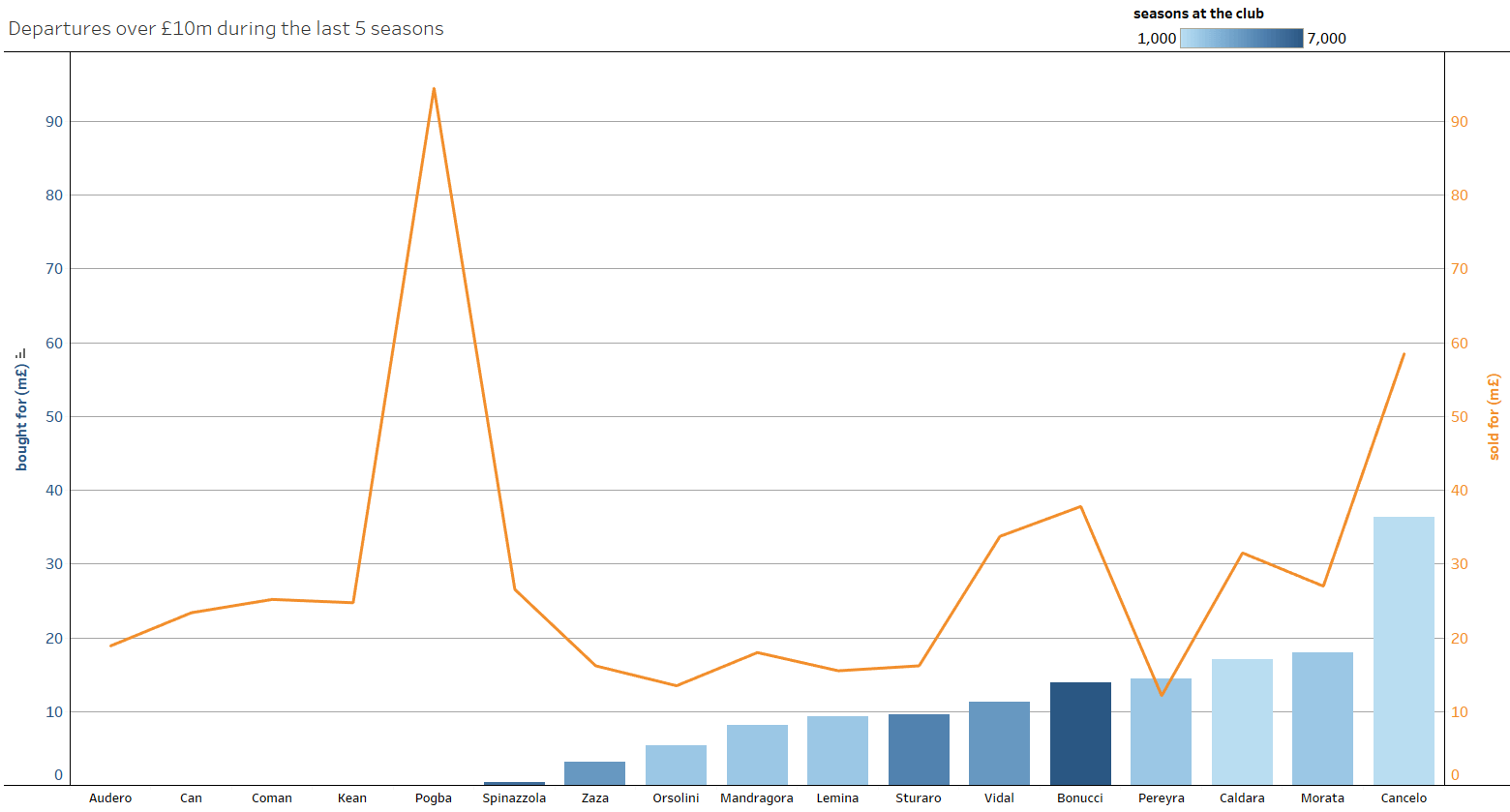
A theme that stands out is that it seems as if they are clever with the way they sell their players. Roberto Pereyra (now in the EPL at Watford) is the only player who cost them more than they sold him for. We already talked about the swap deal of Cancelo and Danilo, therefore we already know the numbers.
The transfer of Paul Pogba logically stands out as Juve signed him for free from Manchester United, only to sell him a few years later to the same club for £94.50 million. Also, Moise Kean (own youth) and Kingsley Coman (brought in for free from PSG) are two young players who they sold for large sums of money, even though Coman could become far more valuable in the future.
Players in this graph like Stefano Sturaro, Leonardo Spinazzola or Riccardo Orsolini are examples of a unique aspect of Juventus’ strategy, one which isn’t recognised that often. The strategy is buying young Italian talents for cheap money (or also products of their own youth academy) to then loan them out to other clubs in Italy where they can develop their skills to then sell them. Also, they signed many of these players for less than £20 million, which explains the high value for such signings in the prior graph in which the different kinds of transfers were visualised.
Many people aren’t aware of how many players in the Serie were part of this process. Therefore, I visualised in the graph below the number of loans of Juve in the last 10 seasons. I must note here that these numbers don’t represent the actual number of players since some young men were loaned out for just half a year while others were gone for several seasons. These numbers look at the numbers Transfermarkt recorded per season.

We can see here that especially in the seasons from 2014/15 to 2017/18, the number of loans exploded. Currently, there are seven players on loan at another club and among them are quite talented players who could probably be implemented into the first squad when they return or be sold for a lot of money. Also, I must outline that the Old Lady mainly loan out the players to clubs in the first two divisions of Italy and also sell the players then to clubs in these leagues. However, not many fans are aware of this system since there are rarely incredibly big names amongst these players.
To round up this recruitment analysis, we will take a final look at the money that Juventus spent and earned in the last five seasons. Of course, we must consider here (as in this whole analysis) that we only looked at the numbers for transfers and don’t have values for wages, sponsorship deals, TV contracts or any other information about the financial situation of the club as we only focus on the selling and buying of the players.
In the final graph below, I visualised all the money spent and earned by Juventus in the last five seasons when it comes to permanent transfers and loans.
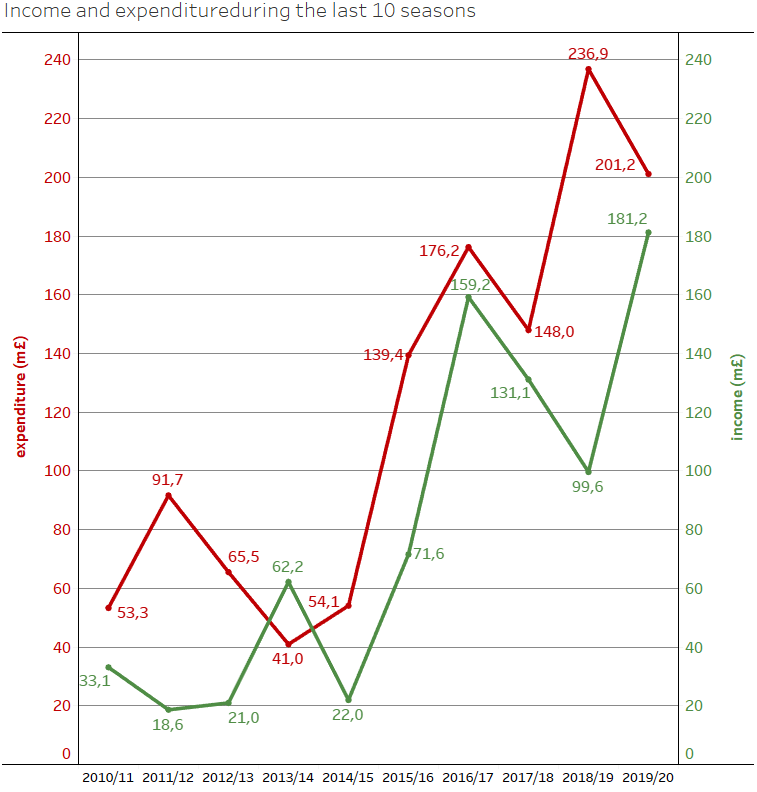
We can see that there is only one season in which they received more money from selling and loaning out players than they actually spent on new ones (2013/14). The second thing that stands out is that from year to year more money is spent in world football. This development and trend respectively can be seen in both income and expenditure.
The overall balance would be even worse if their loaning system wasn’t as successful as it is, since a huge part of the income is a result of that.
Conclusion
Juventus have an incredibly high average age (29.3) which is typical for an Italian team. When we compare average ages of teams across Europe’s top five leagues, in the Serie A we have only one team with an average age that is 26.0 or lower, eight in the Bundesliga, four in the Premier League, one in La Liga and 10 in Ligue 1.
Also, I must note here that all the data (except the ages of the current Juventus player) used in this analysis is from 28 May. However, for the calculation of the ages of the Juventus players is used the release date of this magazine and article to have then the current ages of the players. For example, Bentancur turns 23-years-old exactly on the release date (25 June).
He is one of the very few young players in the squad while the majority of the players are quite old. Because of this, we will likely see one of the loaned out players in Juventus’ senior squad next season, or they could stick with their current strategy of mainly bringing in players in their prime.

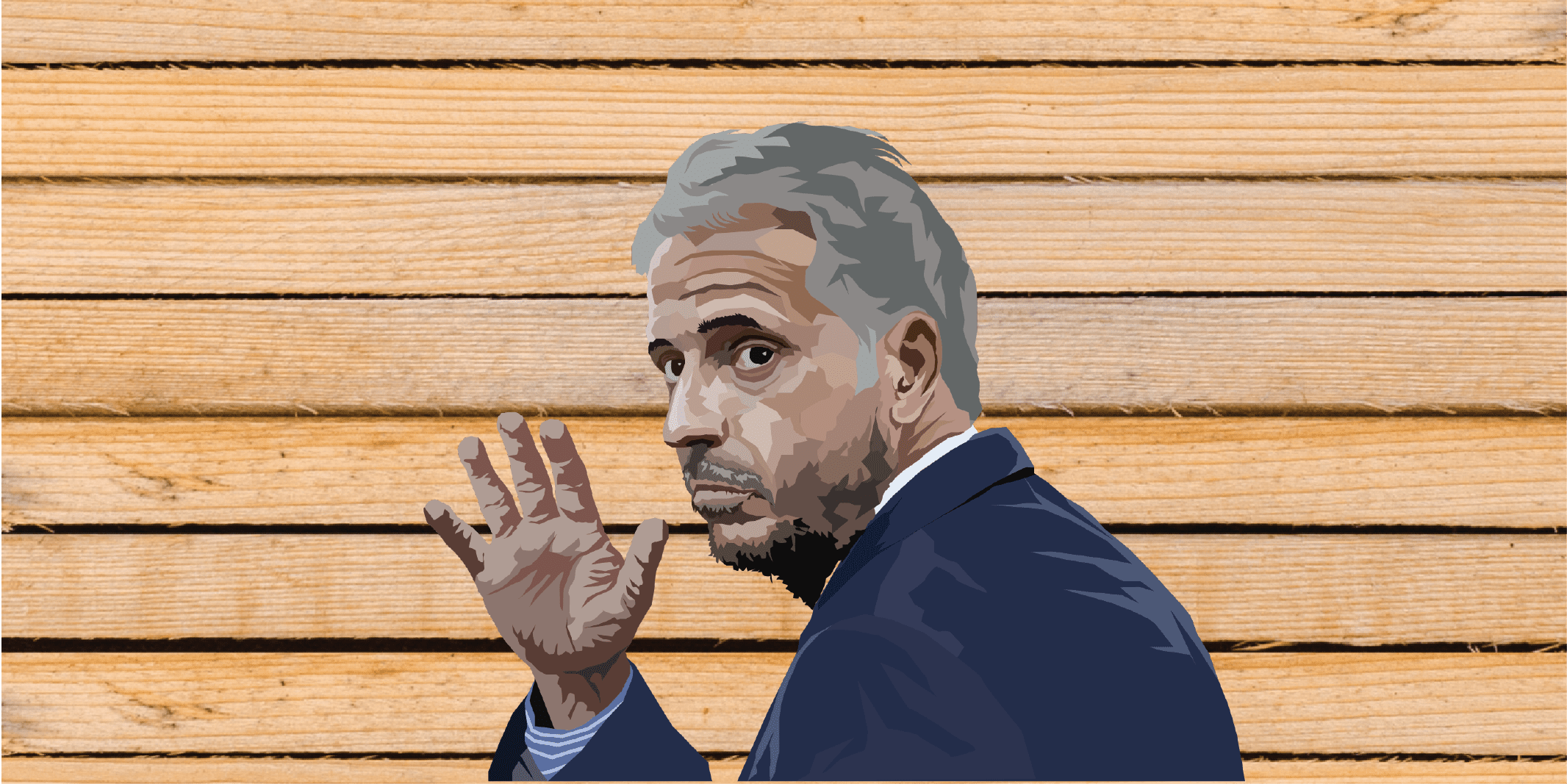


Comments